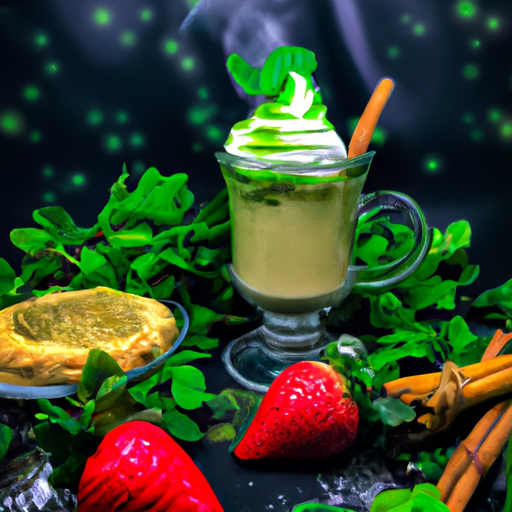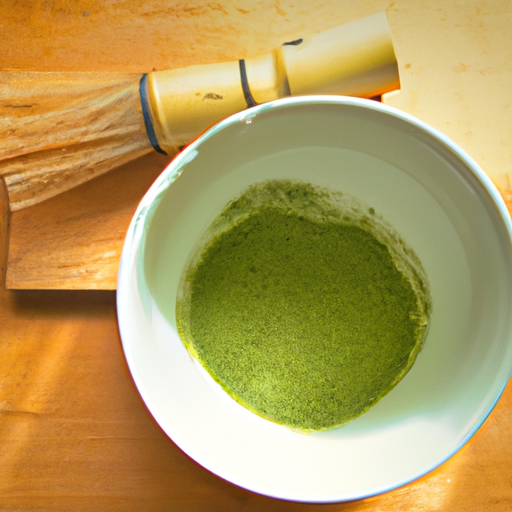As a matcha enthusiast, I constantly seek innovative and delightful methods to savor this vivid green tea powder. However, figuring out the perfect pairing of flavors with matcha often presents a challenge due to the need for a harmonious balance.
The unique flavor profile of matcha can be overwhelming to some, but with a little experimentation and understanding, you can create delicious flavor combinations that complement and enhance the taste of matcha.
Matcha is known for its earthy, vegetal taste and slightly bitter finish. But did you know that there are a variety of flavors that can pair well with matcha? From sweet to savory, bitter to earthy, there are endless possibilities for creating unique and satisfying flavor combinations.
In this article, I’ll be sharing my favorite flavor pairings for matcha, as well as tips for using matcha in cooking and the health benefits of this superfood. So, grab your matcha whisk and let’s get started!
Key Takeaways
- Matcha has a unique flavor profile that is earthy, slightly bitter, and has a hint of sweetness, making it a versatile ingredient for both sweet and savory dishes.
- Matcha comes in different grades, with higher grades having a more delicate and complex flavor profile.
- Matcha has a rich cultural and historical significance in Japanese tea ceremonies and desserts.
- Matcha is a superfood with high levels of antioxidants and L-theanine, making it a healthy ingredient to incorporate into drinks, baking, and savory dishes.
Understanding the Flavor Profile of Matcha
Understanding the flavor profile of matcha is crucial to discovering which flavors complement it best. Matcha is a type of green tea that’s grown in the shade, giving it a unique flavor and texture. The tea leaves are ground into a fine powder, which is then whisked with hot water to create a frothy, creamy drink.
The flavor of matcha can be described as vegetal, grassy, and slightly bitter, with a sweet finish. To understand the different grades of matcha, it’s important to know that the highest quality matcha is made from the youngest tea leaves, which are grown in the shade for several weeks before they’re harvested. This type of matcha is called ceremonial grade matcha, and it has a bright green color and a delicate, complex flavor.
Lower grades of matcha are made from older tea leaves, which are grown in full sun and have a stronger, more astringent flavor. Exploring the cultural significance of matcha in Japanese cuisine is also important when understanding its flavor profile. Matcha has been used in Japanese tea ceremonies for centuries, and it’s considered a symbol of hospitality and respect.
Matcha is also used in a variety of Japanese sweets and desserts, such as matcha mochi and matcha ice cream. As we move into discussing sweet flavors that pair well with matcha, it’s important to keep in mind the unique flavor profile and cultural significance of this green tea. Sweet flavors can help balance out the bitterness of matcha, but they shouldn’t overpower its delicate flavor.
Sweet Flavors That Pair Well with Matcha
If you’re a fan of sweet treats, you’ll love the way matcha dances on your taste buds when paired with sugary delights. While traditional sweet pairings like chocolate and vanilla work well with matcha, exploring unconventional sweet pairings can create an even more delightful experience.
For example, matcha pairs surprisingly well with fruity flavors like mango, raspberry, and strawberry. The fruity sweetness enhances matcha’s natural earthy flavor and provides a refreshing contrast.
Texture also plays a crucial role in enhancing matcha’s flavor. Creamy textures like ice cream and whipped cream complement matcha’s smooth and silky mouthfeel. Matcha also pairs well with crunchy textures like nuts, granola, and biscuits. The crunchiness adds a layer of depth to matcha’s flavor profile and creates a satisfying contrast between the textures.
As you can see, sweet flavors can elevate matcha’s flavor profile to new heights. However, don’t be afraid to experiment and try out new sweet pairings with matcha.
Next, let’s explore how savory flavors can also complement matcha’s unique taste.
Savory Flavors That Pair Well with Matcha
When it comes to savory flavors that pair well with matcha, there are a variety of options to explore. As someone who loves experimenting in the kitchen, I’ve found that umami-rich ingredients such as miso, soy sauce, and mushrooms are great complements to matcha’s grassy notes.
Additionally, salty ingredients such as seaweed, bacon, and cheese can add depth and complexity to matcha-based dishes. And for those who enjoy a bit of spice, spices such as ginger, garlic, and cumin can elevate matcha to a whole new level.
Umami-rich ingredients such as miso, soy sauce, and mushrooms
Using miso, soy sauce, or mushrooms in a matcha dish can add a savory umami flavor that will transport your taste buds to a cozy, earthy forest. As someone who loves incorporating matcha into my cooking, I’ve found that these umami-rich ingredients are a perfect match for the unique flavor of matcha. Umami flavors in Japanese cuisine are often described as a pleasant, savory taste that adds depth and complexity to dishes. When paired with matcha, these flavors create a unique taste experience that is both comforting and invigorating.
To help you understand the potential of matcha and umami, I’ve created a table to showcase some of the best ingredients to pair with matcha. By combining the earthy notes of matcha with the savory tastes of miso, soy sauce, and mushrooms, you can create a dish that is both satisfying and delicious. Whether you’re incorporating matcha into soups, stews, or even pasta dishes, these ingredients will help elevate the flavors and create a meal that is truly unforgettable.
Moving on to the next section, we’ll explore the use of salty ingredients such as seaweed, bacon, and cheese in matcha dishes. With these ingredients, you can create a dish that is both salty and sweet, with a balance of umami and earthy flavors.
Salty ingredients such as seaweed, bacon, and cheese
Get ready to take your matcha dishes to the next level with the addition of salty ingredients like seaweed, bacon, and cheese! These umami-rich ingredients will add a new dimension to your matcha creations, resulting in an umami overload that’s sure to satisfy your taste buds.
Balancing saltiness with the delicate bitterness of matcha can be tricky, but with careful pairing and experimentation, you can achieve a harmonious balance of flavors. Seaweed, for example, adds a subtle saltiness that complements the earthy flavor of matcha.
Bacon, on the other hand, provides a bold and savory flavor that contrasts with the delicate bitterness of matcha. And cheese? Cheese adds a creamy and salty taste that pairs surprisingly well with matcha. So don’t be afraid to try out unexpected pairings and bold experimentation with your matcha dishes!
As we move on to the next section about spices such as ginger, garlic, and cumin, it’s important to remember that the key to creating delicious matcha dishes is all about finding the right balance of flavors.
Spices such as ginger, garlic, and cumin
You’ll be amazed at how spices like ginger, garlic, and cumin can transform your matcha dishes into bold and flavorful creations.
When it comes to using matcha in drinks, adding a pinch of ginger can give your matcha latte a warm and spicy kick. The combination of matcha and ginger can also help boost your immune system and aid in digestion.
For a savory twist, try incorporating garlic and cumin into your matcha dishes. This combination is perfect for adding a bold and earthy flavor to savory baked goods like bread or crackers.
Incorporating matcha into baked goods is a great way to experiment with new flavor combinations. Adding spices like ginger, garlic, and cumin can help balance the natural sweetness of matcha powder and create a complex and delicious taste. The spicy notes of ginger and garlic pair well with matcha’s earthy flavor, while cumin adds a hint of smokiness.
With the right combination of spices, matcha can be used in a variety of dishes, from sweet treats to savory meals. Speaking of which, let’s explore how bitter flavors can complement matcha.
Bitter Flavors That Complement Matcha
If you’re feeling adventurous, it’s worth trying matcha with a touch of dark chocolate to balance out its bitter notes. This combination can create a rich and complex flavor profile that is sure to impress. The bitterness of matcha can be overwhelming for some, but when paired with the right flavors, it can be a delicious treat.
Here are three other bitter flavors that complement matcha:
-
Orange: The citrusy notes of orange can help to brighten up the earthy bitterness of matcha. Adding a few drops of orange juice to your matcha latte can give it a refreshing twist.
-
Grapefruit: Similar to orange, grapefruit can add a tangy and slightly bitter taste to matcha. You can try adding a small amount of grapefruit zest to your matcha powder before whisking it with hot water.
-
Pomegranate: If you’re looking for a fruity and slightly tart flavor to complement matcha, try adding some pomegranate juice to your matcha latte. The sweetness of the juice can help to balance out the bitterness of the matcha.
Exploring alternative bitterness is one way to enhance your matcha experience. Another way is by using matcha in cocktails. Matcha can add a unique flavor to cocktails and can be a great substitute for other bitter ingredients like bitters or amaro.
Moving on to the next subtopic, earthy flavors that enhance matcha, there are a variety of ingredients that pair well with matcha’s grassy and vegetal notes.
Earthy Flavors That Enhance Matcha
As we’ve previously discussed, bitter flavors can be a great complement to matcha. However, there are also other flavors that can enhance the unique taste of this green tea powder. In this section, I’ll be focusing on earthy flavors that pair well with matcha.
When it comes to earthy flavor alternatives, there are plenty of options to choose from. One classic pairing is with roasted brown rice, which adds a nutty taste and a pleasant aroma to the matcha. Another option is to pair matcha with seaweed, which gives a subtle oceanic flavor that’s not overpowering.
Other earthy flavors to consider include mushrooms, barley, and even root vegetables like sweet potato. If you’re feeling adventurous, you can also try pairing matcha with non-traditional ingredients that have an earthy flavor.
For example, avocado and matcha might not seem like an obvious pairing, but the creamy texture of the avocado and the grassy taste of the matcha can create a surprisingly delicious combination. Another unexpected pairing is with dark chocolate, which adds a rich, earthy flavor that complements the bitterness of the matcha.
With so many earthy flavor alternatives to choose from, the possibilities for creating unique matcha combinations are endless. In the next section, we’ll be discussing the importance of experimenting with different flavor combinations to truly discover the perfect matcha pairing.
Experimenting with Different Flavor Combinations
Don’t be afraid to get creative and try out unusual ingredients to find the perfect matcha combination that matches your unique taste preferences. Mixing drinks and unique desserts are great ways to experiment with different flavor combinations.
For example, try mixing matcha with coconut milk and honey for a creamy and sweet drink. Or, mix matcha with avocado and lime for a refreshing and tangy smoothie.
Another way to experiment with matcha is to incorporate it into unique desserts. Matcha pairs well with chocolate, so try making matcha chocolate truffles or matcha chocolate bark. Matcha also goes well with citrus flavors, so try making a matcha lemon tart or matcha orange sorbet. The possibilities are endless when it comes to using matcha in desserts.
When experimenting with different flavor combinations, it’s important to keep in mind that matcha has a strong flavor and can easily overpower other ingredients. Start with a small amount of matcha and gradually increase it until you find the right balance. Remember, the goal is to enhance the flavor of the matcha, not mask it.
With a little bit of experimentation, you can find the perfect matcha combination that matches your unique taste preferences. Incorporating matcha into your cooking can be a fun and delicious experience.
In the next section, I’ll share some tips for using matcha in cooking to elevate your dishes to the next level.
Tips for Using Matcha in Cooking
Enhance the richness and depth of your favorite savory dishes by incorporating the earthy, vibrant tones of matcha powder. Not only does matcha add a unique flavor, but it also provides a boost of antioxidants and other health benefits.
Using matcha in baking is a great way to experiment with this ingredient. Adding matcha to your favorite muffin or cookie recipe can give your baked goods a subtle, yet distinct flavor. You can even make matcha-infused frosting or glaze to top your creations with.
Incorporating matcha into drinks is another popular way to use this ingredient. Matcha lattes are a delicious and healthy alternative to coffee-based drinks. Simply whisk matcha powder into hot water, add your desired sweetener and milk, and enjoy. You can also add matcha powder to smoothies or juices for an extra antioxidant boost. Matcha-infused cocktails have also become trendy in recent years, adding a unique twist to traditional drinks.
Using matcha in cooking and drinks is a fun and creative way to experiment with this versatile ingredient. Whether you’re baking or creating a refreshing drink, adding matcha can enhance the flavor and provide health benefits.
In the next section, we’ll explore the many health benefits of matcha and how it can improve your overall well-being.
Health Benefits of Matcha
You’ll be amazed at the numerous health benefits that matcha can provide for your body and mind. Matcha is often referred to as a superfood because of its high concentration of antioxidants, which can help to reduce inflammation and slow down the aging process.
Additionally, matcha contains high levels of L-theanine, an amino acid that promotes relaxation and helps to reduce stress and anxiety. There are many different ways to consume matcha, but one of the most popular is to drink it as a tea.
Matcha tea is made by whisking the powdered tea leaves into hot water, creating a frothy and delicious beverage. You can also add matcha powder to smoothies, baked goods, and even savory dishes like soups and sauces. This versatility makes matcha a great ingredient to have on hand in the kitchen.
If you’re looking to incorporate more matcha into your diet, there are plenty of delicious recipes to try. From matcha lattes to matcha-infused desserts, the possibilities are endless. So why not give it a try and see how matcha can benefit your health and add some delicious flavor to your meals?
Matcha Recipes to Try
Indulge in the rich and creamy goodness of a matcha latte or satisfy your sweet tooth with matcha-infused desserts. Matcha is a versatile ingredient that can be used in a variety of desserts and drinks. From matcha ice cream to matcha smoothies, there are endless possibilities to explore.
If you love desserts, then matcha can be a perfect addition to your recipe collection. Matcha desserts are becoming increasingly popular, and for a good reason. They’re not only delicious but also healthy. Matcha is packed with antioxidants and has a unique flavor that can enhance the taste of any dessert.
Some popular matcha desserts include matcha cheesecake, matcha tiramisu, and matcha macarons. Matcha drinks are also a great way to incorporate this ingredient into your diet. Matcha lattes are a popular choice and can be made with almond or soy milk for a dairy-free alternative. Matcha smoothies are also a delicious and healthy option. Simply blend matcha powder with your favorite fruits, almond milk, and ice for a refreshing drink.
With these recipes, you can enjoy the benefits of matcha while satisfying your sweet cravings.
Frequently Asked Questions
What is the origin of matcha and how has it been traditionally consumed?
As a matcha enthusiast, I can tell you that the origin of matcha can be traced back to Japan, where it has been consumed for centuries as a part of traditional tea ceremonies. Matcha is made from shade-grown green tea leaves that are ground into a fine powder.
In traditional preparation methods, the powder is whisked with hot water using a bamboo whisk until it forms a frothy, smooth consistency. This method allows for the consumption of the entire tea leaf, resulting in a higher concentration of antioxidants and other health benefits than regular green tea.
Matcha is known for its ability to boost metabolism, promote relaxation, and improve mental clarity. Its unique flavor profile is described as earthy, vegetal, and slightly bitter, with a creamy texture. While matcha is often enjoyed on its own, it can also be used in cooking and baking to add a unique flavor and bright green color.
Can matcha be used as a substitute for other ingredients in recipes, and if so, which ones?
When it comes to using matcha as a substitute in recipes, there are both possibilities and limitations. Matcha can be a great substitute for green tea powder in recipes, adding a unique flavor and vibrant green color to dishes such as smoothies, cakes, and ice creams.
It can also be used to replace some of the sugar in recipes, as it has a natural sweetness to it. However, it may not work well as a substitute for other ingredients like flour or eggs due to its distinct flavor and texture.
Overall, using matcha as a substitute requires some experimentation and creativity to find the right balance in each recipe.
How does the quality of matcha affect its flavor and pairing options?
When it comes to matcha, the quality of the tea powder plays a huge role in its flavor and pairing options. Matcha grades, such as ceremonial or culinary, can greatly affect the taste of the tea.
I find that higher quality matcha, like ceremonial grade, has a smoother and more delicate flavor, while lower quality matcha, like culinary grade, can have a bitter taste. Brewing matcha for taste is also important.
If the water is too hot or the matcha is over whisked, it can result in a bitter taste. When it comes to pairing with savory dishes, I find that matcha goes well with dishes that have umami flavors, like miso soup or mushroom risotto.
The earthy and slightly bitter notes of matcha can complement these flavors nicely. Overall, understanding the quality of matcha and how to brew it properly can enhance its flavor and pairing options.
Are there any cultural or regional differences in how matcha is used in cooking?
Cultural variations in the use of matcha in cooking are fascinating and reflect the diverse culinary traditions across the world.
In Japan, matcha is typically used to make sweets, such as mochi and wagashi, and is also enjoyed in tea ceremonies.
Meanwhile, in modern fusion cuisine, matcha has found its way into a variety of dishes, from savory dishes like matcha pasta to sweet treats like matcha ice cream.
These cultural variations reflect the versatility of matcha and its ability to complement a wide range of flavors.
As a matcha enthusiast, I’ve been amazed by the creativity and innovation that chefs around the world have brought to this traditional ingredient.
It’s truly a testament to the power of food to unite people across cultures and time.
What are some unique or unexpected flavor combinations that work well with matcha?
When it comes to matcha flavor pairings, there are plenty of unexpected matcha combinations that work well together.
One unique option is to combine matcha with citrus flavors, such as lemon or grapefruit, which can provide a bright and refreshing contrast to the earthy matcha taste.
Another unexpected pairing is with caramel or chocolate, which can add a rich and decadent sweetness to the bitter matcha.
For a more savory option, matcha can be paired with ingredients like miso or soy sauce to enhance its umami flavor.
Overall, there are many surprising and delicious ways to incorporate matcha into your cuisine.
Conclusion
Well, folks, it seems like we’ve come to the end of our journey exploring the wonderful world of matcha and its flavor pairings. After trying out a few of the suggestions in this article, I must say, I’m pleasantly surprised by the results.
Who knew that a bitter green tea powder could pair so well with sweet vanilla or savory avocado? But let’s not forget about the health benefits of matcha, which make it all the more worthwhile to experiment with in the kitchen.
From boosting metabolism to providing a calming effect, matcha truly is a powerhouse ingredient. So next time you’re feeling adventurous in the kitchen, give matcha a try and see what unique flavor combinations you can come up with. Happy cooking!










